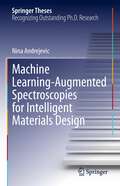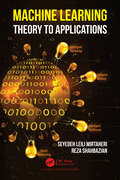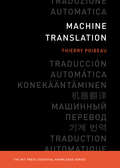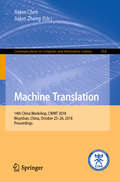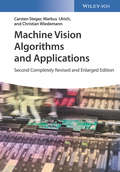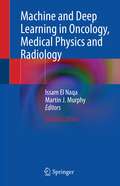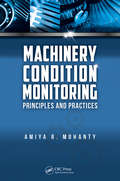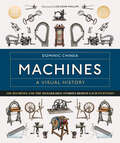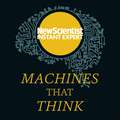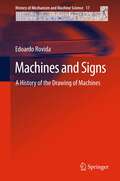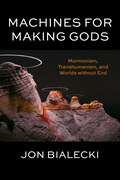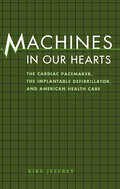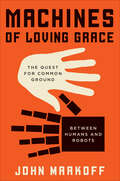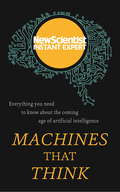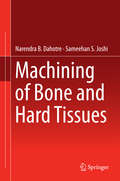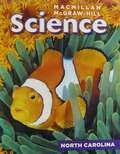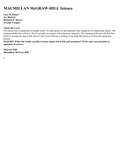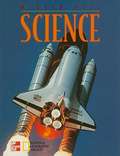- Table View
- List View
Machine Learning-Augmented Spectroscopies for Intelligent Materials Design (Springer Theses)
by Nina AndrejevicThe thesis contains several pioneering results at the intersection of state-of-the-art materials characterization techniques and machine learning. The use of machine learning empowers the information extraction capability of neutron and photon spectroscopies. In particular, new knowledge and new physics insights to aid spectroscopic analysis may hold great promise for next-generation quantum technology. As a prominent example, the so-called proximity effect at topological material interfaces promises to enable spintronics without energy dissipation and quantum computing with fault tolerance, yet the characteristic spectral features to identify the proximity effect have long been elusive. The work presented within permits a fine resolution of its spectroscopic features and a determination of the proximity effect which could aid further experiments with improved interpretability. A few novel machine learning architectures are proposed in this thesis work which leverage the case when the data is scarce and utilize the internal symmetry of the system to improve the training quality. The work sheds light on future pathways to apply machine learning to augment experiments.
Machine Learning: Theory to Applications
by Seyedeh Leili Mirtaheri Reza ShahbazianThe book reviews core concepts of machine learning (ML) while focusing on modern applications. It is aimed at those who want to advance their understanding of ML by providing technical and practical insights. It does not use complicated mathematics to explain how to benefit from ML algorithms. Unlike the existing literature, this work provides the core concepts with emphasis on fresh ideas and real application scenarios. It starts with the basic concepts of ML and extends the concepts to the different deep learning algorithms. The book provides an introduction and main elements of evaluation tools with Python and walks you through the recent applications of ML in self-driving cars, cognitive decision making, communication networks, security, and signal processing. The concept of generative networks is also presented and focuses on GANs as a tool to improve the performance of existing algorithms. In summary, this book provides a comprehensive technological path from fundamental theories to the categorization of existing algorithms, covers state-of-the-art, practical evaluation tools and methods to empower you to use synthetic data to improve the performance of applications.
Machine Translation (The MIT Press Essential Knowledge series)
by Thierry PoibeauA concise, nontechnical overview of the development of machine translation, including the different approaches, evaluation issues, and major players in the industry.The dream of a universal translation device goes back many decades, long before Douglas Adams's fictional Babel fish provided this service in The Hitchhiker's Guide to the Galaxy. Since the advent of computers, research has focused on the design of digital machine translation tools—computer programs capable of automatically translating a text from a source language to a target language. This has become one of the most fundamental tasks of artificial intelligence. This volume in the MIT Press Essential Knowledge series offers a concise, nontechnical overview of the development of machine translation, including the different approaches, evaluation issues, and market potential. The main approaches are presented from a largely historical perspective and in an intuitive manner, allowing the reader to understand the main principles without knowing the mathematical details. The book begins by discussing problems that must be solved during the development of a machine translation system and offering a brief overview of the evolution of the field. It then takes up the history of machine translation in more detail, describing its pre-digital beginnings, rule-based approaches, the 1966 ALPAC (Automatic Language Processing Advisory Committee) report and its consequences, the advent of parallel corpora, the example-based paradigm, the statistical paradigm, the segment-based approach, the introduction of more linguistic knowledge into the systems, and the latest approaches based on deep learning. Finally, it considers evaluation challenges and the commercial status of the field, including activities by such major players as Google and Systran.
Machine Translation: 14th China Workshop, Cwmt 2018, Wuyishan, China, October 25-26, 2018, Proceedings (Communications in Computer and Information Science #954)
by Jiajun Chen Jiajun ZhangThis book constitutes the refereed proceedings of the 14th China Workshop on Machine Translation, CWMT 2018, held in Wuyishan, China, in October 2018. The 9 papers presented in this volume were carefully reviewed and selected from 17 submissions and focus on all aspects of machine translation, including preprocessing, neural machine translation models, hybrid model, evaluation method, and post-editing.
Machine Vision Algorithms and Applications
by Christian Wiedemann Carsten Steger Markus UlrichThe second edition of this successful machine vision textbook is completely updated, revised and expanded by 15% to reflect the developments of recent years in the fields of image acquisition, machine vision algorithms and applications. The new content includes, but is not limited to, a discussion of new cameras and image acquisition interfaces, 3D sensors and technologies, 3D object recognition and 3D image reconstruction. The authors retain their balanced approach with sufficient coverage of the theory and a strong focus on applications. All examples are based on the latest version of the machine vision software HALCON 13, a trial version of which is available from the authors' website.
Machine and Deep Learning in Oncology, Medical Physics and Radiology
by Issam El Naqa Martin J. MurphyThis book, now in an extensively revised and updated second edition, provides a comprehensive overview of both machine learning and deep learning and their role in oncology, medical physics, and radiology. Readers will find thorough coverage of basic theory, methods, and demonstrative applications in these fields. An introductory section explains machine and deep learning, reviews learning methods, discusses performance evaluation, and examines software tools and data protection. Detailed individual sections are then devoted to the use of machine and deep learning for medical image analysis, treatment planning and delivery, and outcomes modeling and decision support. Resources for varying applications are provided in each chapter, and software code is embedded as appropriate for illustrative purposes. The book will be invaluable for students and residents in medical physics, radiology, and oncology and will also appeal to more experienced practitioners and researchers and members of applied machine learning communities.
Machine and Sovereignty: For a Planetary Thinking
by Yuk HuiDeveloping a new political thought to address today&’s planetary crises What is &“planetary thinking&” today? Arguing that a new approach is urgently needed, Yuk Hui develops a future-oriented mode of political thought that encompasses the unprecedented global challenges we are confronting: the rise of artificial intelligence, the ecological crisis, and intensifying geopolitical conflicts. Machine and Sovereignty starts with three premises. The first affirms the necessity of developing a new language of coexistence that surpasses the limits of nation-states and their variations; the second recognizes that political forms, including the polis, empire, and the state, are technological phenomena, which Lewis Mumford terms &“megamachines.&” The third suggests that a particular political form is legitimated and rationalized by a corresponding political epistemology. The planetary thinking that this book sketches departs from the opposition between mechanism and organism, which characterized modern thought, to understand the epistemological foundations of Hegel&’s political state and Schmitt&’s Großraum and their particular ways of conceiving the question of sovereignty. Through this reconstruction, Hui exposes the limits of the state and reflects on a new theoretical matrix based on the interrelated concepts of biodiversity, noodiversity, and technodiversity. Arguing that we are facing the limit of modernity, of the eschatological view of history, of globalization, and of the human, Hui conceives necessary new epistemological and technological frameworks for understanding and rising to the crises of our present and our future. Retail e-book files for this title are screen-reader friendly.
Machinery Condition Monitoring: Principles and Practices
by Amiya Ranjan MohantyFind the Fault in the Machines- Drawing on the author’s more than two decades of experience with machinery condition monitoring and consulting for industries in India and abroad, Machinery Condition Monitoring: Principles and Practices introduces the practicing engineer to the techniques used to effectively detect and diagnose faults in machines. Providing the working principle behind the instruments, the important elements of machines as well as the technique to understand their conditions, this text presents every available method of machine fault detection occurring in machines in general, and rotating machines in particular.A Single-Source Solution for Practice Machinery Conditioning Monitoring- Since vibration is one of the most widely used fault detection techniques, the book offers an assessment of vibration analysis and rotor-dynamics. It also covers the techniques of wear and debris analysis, and motor current signature analysis to detect faults in rotating mechanical systems as well as thermography, the nondestructive test NDT techniques (ultrasonics and radiography), and additional methods. The author includes relevant case studies from his own experience spanning over the past 20 years, and detailing practical fault diagnosis exercises involving various industries ranging from steel and cement plants to gas turbine driven frigates. While mathematics is kept to a minimum, he also provides worked examples and MATLAB® codes.This book contains 15 chapters and provides topical information that includes: A brief overview of the maintenance techniques Fundamentals of machinery vibration and rotor dynamics Basics of signal processing and instrumentation, which are essential for monitoring the health of machines Requirements of vibration monitoring and noise monitoring Electrical machinery faults Thermography for condition monitoring Techniques of wear debris analysis and some of the nondestructive test (NDT) techniques for condition monitoring like ultrasonics and radiography Machine tool condition monitoring Engineering failure analysis Several case studies, mostly on failure analysis, from the author’s consulting experience Machinery Condition Monitoring: Principles and Practices presents the latest techniques in fault diagnosis and prognosis, provides many real-life practical examples, and empowers you to diagnose the faults in machines all on your own.
Machines A Visual History: 100 Machines and the Remarkable Stories Behind Each Invention
by Dominic ChineaThe Repair Shop's Dom Chinea takes you on an exploration of more than 120 essential machines found in the workshops and studios of the world's finest artisans and heritage craftspeople.Having covered tools in his first book, Dominic Chinea turns his attention to machines. Featuring more than 120 machines, defined as items with a mechanism to help transfer energy, Dom looks at objects, including the potter's wheel, grain mill, sewing machine, printing press, wheel maker, and plenty more. Each machine has a fascinating history and story to tell that highlights its contribution to artisanal crafts. And with every machine accompanied by beautifully ornate illustrations by Lee John Philips, it's certain to be a treasured book for all creators and craftspeople.
Machines That Think: Everything You Need to Know About the Coming Age of Artificial Intelligence (New Scientist Instant Expert)
by New ScientistMachines That Think explores how artificial intelligence helps us understand human intelligence, machines that compose music and write stories - and asks if AI is really a threat. <p><p>Sometime in the future the intelligence of machines will exceed that of human brain power. So are we on the edge of an AI-pocalypse, with superintelligent devices superseding humanity, as predicted by Stephen Hawking? Or will this herald a kind of Utopia, with machines doing a far better job at complex tasks than us? <p><p>You might not realise it, but you interact with AIs every day. They route your phone calls, approve your credit card transactions and help your doctor interpret results. Driverless cars will soon be on the roads with a decision-making computer in charge. But how do machines actually think and learn? <p><p>In Machines That Think, AI experts and New Scientist explore how artificial intelligence helps us understand human intelligence, machines that compose music and write stories - and ask if AI is really a threat. <P><P>ABOUT THE SERIES <p>New Scientist Instant Expert books are definitive and accessible entry points to the most important subjects in science; subjects that challenge, attract debate, invite controversy and engage the most enquiring minds. Designed for curious readers who want to know how things work and why, the Instant Expert series explores the topics that really matter and their impact on individuals, society, and the planet, translating the scientific complexities around us into language that's open to everyone, and putting new ideas and discoveries into perspective and context. <p>(P)2017 Hodder & Stoughton Limited
Machines and Signs
by Edoardo RovidaThis volume addresses the cultural, technical and ethical motivations of the history of drawing of machines and its developments step by step. First it treats drawings without any technical character; then the Renaissance with its new forms of drawing; the 18th century, with orthographic projections, immediately used by industry; the 19th century, including the applications of drawing in industry; and the 20th century, with the standardization institutions and the use of the computer. The role of historical drawings and archives in modern design is also examined. This book is of value to all those who are interested in technical drawing, either from an artistic, from a design, or from an engineering point of view.
Machines for Making Gods: Mormonism, Transhumanism, and Worlds without End
by Jon BialeckiThe Mormon faith may seem so different from aspirations to transcend the human through technological means that it is hard to imagine how these two concerns could even exist alongside one another, let alone serve together as the joint impetus for a social movement. Machines for Making Gods investigates the tensions between science and religion through which an imaginative group of young Mormons and ex-Mormons have found new ways of understanding the world.The Mormon Transhumanist Association (MTA) believes that God intended humanity to achieve Mormonism’s promise of theosis through imminent technological advances. Drawing on a nineteenth-century Mormon tradition of religious speculation to reimagine Mormon eschatological hopes as near-future technological possibilities, they envision such current and possible advances as cryonic preservation, computer simulation, and quantum archeology as paving the way for the resurrection of the dead, the creation of worlds without end, and promise of undergoing theosis—of becoming a god. Addressing the role of speculation in the anthropology of religion, Machines for Making Gods undoes debates about secular transhumanism’s relation to religion by highlighting the differences an explicitly religious transhumanism makes.Charting the conflicts and resonances between secular transhumanism and Mormonism, Bialecki shows how religious speculation has opened up imaginative horizons to give birth to new forms of Mormonism, including a particular progressive branch of the faith and even such formations as queer polygamy. The book also reveals how the MTA’s speculative account of God and technology together has helped to forestall some of the social pressure that comes with apostasy in much of the Mormon Intermountain West.A fascinating ethnography of a group with much to say about crucial junctures of modern culture, Machines for Making Gods illustrates how the scientific imagination can be better understood when viewed through anthropological accounts of myth.
Machines in Our Hearts: The Cardiac Pacemaker, the Implantable Defibrillator, and American Health Care
by Kirk JeffreyToday hundreds of thousands of Americans carry pacemakers and implantable cardioverter-defibrillators (ICDs) within their bodies. These battery-powered machines—small computers, in fact—deliver electricity to the heart to correct dangerous disorders of the heartbeat. But few doctors, patients, or scholars know the history of these devices or how "heart-rhythm management" evolved into a multi-billion-dollar manufacturing and service industry. Machines in Our Hearts tells the story of these two implantable medical devices. Kirk Jeffrey, a historian of science and technology, traces the development of knowledge about the human heartbeat and follows surgeons, cardiologists, and engineers as they invent and test a variety of electronic devices. Numerous small manufacturing firms jumped into pacemaker production but eventually fell by the wayside, leaving only three American companies in the business today. Jeffrey profiles pioneering heart surgeons, inventors from the realms of engineering and medical research, and business leaders who built heart-rhythm management into an industry with thousands of employees and annual revenues in the hundreds of millions. As Jeffrey shows, the pacemaker (first implanted in 1958) and the ICD (1980) embody a paradox of high-tech health care: these technologies are effective and reliable but add billions to the nation's medical bill because of the huge growth in the number of patients who depend on implanted devices to manage their heartbeats.
Machines of Loving Grace: The Quest for Common Ground Between Humans and Robots
by John MarkoffRobots are poised to transform today's society as completely as the Internet did twenty years ago. Pulitzer prize-winning New York Times science writer John Markoff argues that we must decide to design ourselves into our future, or risk being excluded from it altogether.In the past decade, Google introduced us to driverless cars; Apple debuted Siri, a personal assistant that we keep in our pockets; and an Internet of Things connected the smaller tasks of everyday life to the farthest reaches of the Web. Robots have become an integral part of society on the battlefield and the road; in business, education, and health care. Cheap sensors and powerful computers will ensure that in the coming years, these robots will act on their own. This new era offers the promise of immensely powerful machines, but it also reframes a question first raised more than half a century ago, when the intelligent machine was born. Will we control these systems, or will they control us?In Machines of Loving Grace, John Markoff offers a sweeping history of the complicated and evolving relationship between humans and computers. In recent years, the pace of technological change has accelerated dramatically, posing an ethical quandary. If humans delegate decisions to machines, who will be responsible for the consequences? As Markoff chronicles the history of automation, from the birth of the artificial intelligence and intelligence augmentation communities in the 1950s and 1960s, to the modern-day brain trusts at Google and Apple in Silicon Valley, and on to the expanding robotics economy around Boston, he traces the different ways developers have addressed this fundamental problem and urges them to carefully consider the consequences of their work. We are on the brink of the next stage of the computer revolution, Markoff argues, and robots will profoundly transform modern life. Yet it remains for us to determine whether this new world will be a utopia. Moreover, it is now incumbent upon the designers of these robots to draw a bright line between what is human and what is machine.After nearly forty years covering the tech industry, Markoff offers an unmatched perspective on the most drastic technology-driven societal shifts since the introduction of the Internet. Machines of Loving Grace draws on an extensive array of research and interviews to present an eye-opening history of one of the most pressing questions of our time, and urges us to remember that we still have the opportunity to design ourselves into the future—before it's too late.
Machines of Nature and Corporeal Substances in Leibniz
by Justin E. Smith Ohad NachtomyIn recent decades, there has been much scholarly controversy as to the basic ontological commitments of the philosopher Gottfried Wilhelm Leibniz (1646-1716). The old picture of his thought as strictly idealistic, or committed to the ultimate reduction of bodies to the activity of mind, has come under attack, but Leibniz's precise conceptualization of bodies, and the role they play in his system as a whole, is still the subject of much controversy. One thing that has become clear is that in order to understand the nature of body in Leibniz, and the role body plays in his philosophy, it is crucial to pay attention to the related concepts of organism and of corporeal substance, the former being Leibniz's account of the structure of living bodies (which turn out, for him, to be the only sort of bodies there are), and the latter being an inheritance from the Aristotelian hylomorphic tradition which Leibniz appropriates for his own ends. This volume brings together papers from many of the leading scholars of Leibniz's thought, all of which deal with the cluster of questions surrounding Leibniz's philosophy of body.
Machines that Think: Everything you need to know about the coming age of artificial intelligence (Instant Expert Ser.)
by New ScientistSometime in the future the intelligence of machines will exceed that of human brain power. So are we on the edge of an AI-pocalypse, with superintelligent devices superseding humanity, as predicted by Stephen Hawking? Or will this herald a kind of Utopia, with machines doing a far better job at complex tasks than us? You might not realise it, but you interact with AIs every day. They route your phone calls, approve your credit card transactions and help your doctor interpret results. Driverless cars will soon be on the roads with a decision-making computer in charge. But how do machines actually think and learn? In Machines That Think, AI experts and New Scientist explore how artificial intelligence helps us understand human intelligence, machines that compose music and write stories - and ask if AI is really a threat.ABOUT THE SERIESNew Scientist Instant Expert books are definitive and accessible entry points to the most important subjects in science; subjects that challenge, attract debate, invite controversy and engage the most enquiring minds. Designed for curious readers who want to know how things work and why, the Instant Expert series explores the topics that really matter and their impact on individuals, society, and the planet, translating the scientific complexities around us into language that's open to everyone, and putting new ideas and discoveries into perspective and context.
Machines that Think: Everything you need to know about the coming age of artificial intelligence (New Scientist Instant Expert)
by New ScientistSometime in the future the intelligence of machines will exceed that of human brain power. So are we on the edge of an AI-pocalypse, with superintelligent devices superseding humanity, as predicted by Stephen Hawking? Or will this herald a kind of Utopia, with machines doing a far better job at complex tasks than us? You might not realise it, but you interact with AIs every day. They route your phone calls, approve your credit card transactions and help your doctor interpret results. Driverless cars will soon be on the roads with a decision-making computer in charge. But how do machines actually think and learn? In Machines That Think, AI experts and New Scientist explore how artificial intelligence helps us understand human intelligence, machines that compose music and write stories - and ask if AI is really a threat.ABOUT THE SERIESNew Scientist Instant Expert books are definitive and accessible entry points to the most important subjects in science; subjects that challenge, attract debate, invite controversy and engage the most enquiring minds. Designed for curious readers who want to know how things work and why, the Instant Expert series explores the topics that really matter and their impact on individuals, society, and the planet, translating the scientific complexities around us into language that's open to everyone, and putting new ideas and discoveries into perspective and context.
Machining of Bone and Hard Tissues
by Narendra Dahotre Sameehan JoshiThis book provides an in-depth review of state-of-the-art orthopaedic techniques and basic mechanical operations (drilling, boring, cutting, grinding/milling) involved in present day orthopaedic surgery. Casting a light on exploratory hybrid operations, as well as non-conventional techniques such as laser assisted operations, this book further extends the discussion to include physical aspects of the surgery in view of material (bone) and process parameters. Featuring detailed discussion of the computational modeling of forces (mechanical and thermal) involved in surgical procedures for the planning and optimization of the process/procedure and system development, this book lays the foundations for efforts towards the future development of improved orthopaedic surgery. With topics including the role of bone machining during surgical operations; the physical properties of the bone which influence the response to any machining operation, and robotic automation, this book will be a valuable and comprehensive literature source for years to come.
Machining of Light Alloys: Aluminum, Titanium, and Magnesium (Manufacturing Design and Technology)
by J. Paulo Davim Diego CarouAluminium, magnesium and titanium are alloys of special interest for engineering applications in a wide range of sectors such as aeronautics, automotive and medical. Their low density, along with sufficient mechanical properties, makes them especially adequate for sectors such as transportation allowing diminishing weight less fuel consumption and emissions to the atmosphere. <P><P>Nowadays, machining is still one the most important manufacturing processes, not only for metal parts, but also for specially designed hybrid parts for more demanding new applications. A wide range of valuable research has been done on the machining of conventional engineering materials. However, when dealing with light alloys and hybrid materials containing them, they need to face new challenges. Particularly, it is important to analyse the suitability of the machining of these alloys in the current context of Industry 4.0, focusing on the development of cost-effective and sustainable processes. <P><P>This book is a comprehensive source on the machining of light alloys, presenting a collection of both experimental and review studies. The work is arranged in eight chapters, presented by a group of international scholars, which analyse the main problems related to the machining of these alloys from different perspectives. <P><P>Key Features <li>A comprehensive state-of-the-art reference source on machining of light alloys <li>Provides research on conventional and non-conventional machining process <li>Offers current research topics on sustainable machining <li>Presents research on the machining of hybrid materials using light alloys <li>Includes applications for Industry 4.0 environments <P><P>Machining of Light Alloys: Aluminum, Titanium, and Magnesium The aim of the book is to serve as a tool for helping researchers and practitioners to face machining challenges and facilitating the development of new industrial applications for light alloys.
Macmillan McGraw Hill Science
by Lucy H. DanielMacmillan/McGraw-Hill Science employs a unique lesson plan to develop science concepts three ways: through purposeful, hands-on activities; compelling reading content; and dynamic visuals and graphics. Key partnerships include Sally Ride Science and TIME For Kids.
Macmillan McGraw Hill Science: Grade 5 Unit B Living Things and Their Environment
by Lucy Daniel Jay Hackett Richard Moyer JoAnne VasquezMacmillan McGraw Hill Science Grade 5 Unit B Living Things and Their Environment by Richard Moyer, Jay Hackett, Lucy Daniel, and JoAnne Vasquez.
Macmillan McGraw-Hill Science
by Richard H. Moyer Joanne Vasquez Jay Hackett Pamela Stryker H. Prentice Baptiste Lucy H. DanielExtensively dealing with the subject of Science, this book covers Life Science, Physical Science and Earth Science.
Macmillan McGraw-Hill Science (Grade #5)
by Richard H. Moyer Joanne Vasquez Jay Hackett Lucy H. DanielThis McGraw-Hill Science (Grade 5) contains unit lessons on Life Science, Living Things, Earth Science, and Physical Science.
Macmillan McGraw-Hill Science (Grade #6)
by Richard H. Moyer Joanne Vasquez Jay Hackett Lucy H. DanielScience is a way of understanding the world around us. The work of scientists often begins when scientists ask questions about something they observe. Asking and answering questions is the basis of inquiry.
